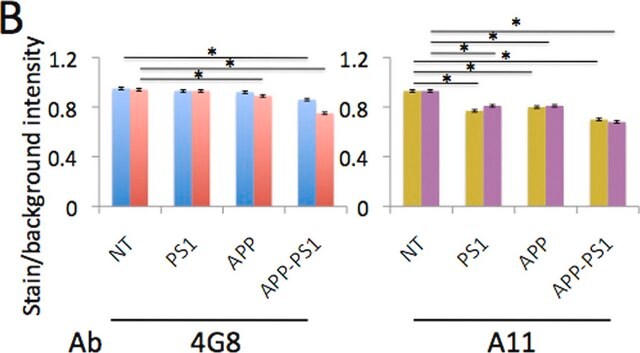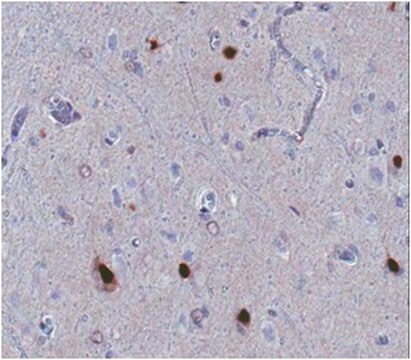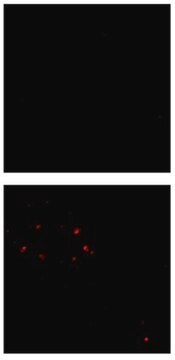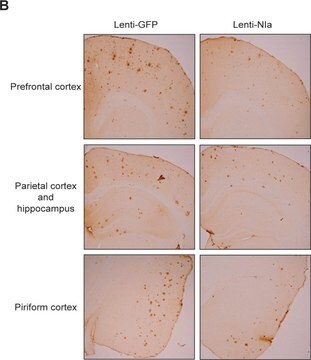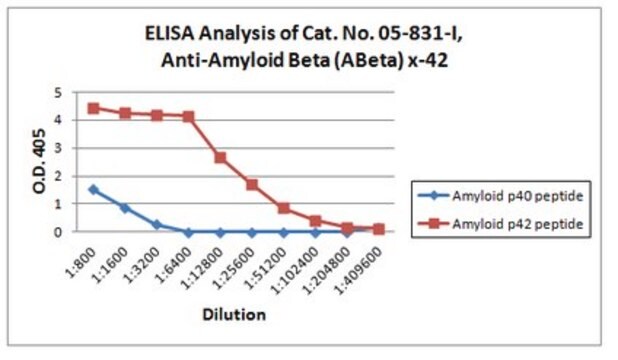MABN879
Anti-phospho-Amyloid beta Antibody (Ser26), clone 5H11C10
clone 5H11C10, from mouse
Sinónimos:
Aβ peptide, Ser26 phosphorylated, Abeta peptide, Ser26 phosphorylated, Amyloid β peptide, Ser26 phosphorylated, Aβ1-40, Ser26 phosphorylated, Aβ1-42, Ser26 phosphorylated, Abeta1-40, Ser26 phosphorylated, Abeta1-42, Ser26 phosphorylat
About This Item
Productos recomendados
origen biológico
mouse
Nivel de calidad
forma del anticuerpo
purified immunoglobulin
tipo de anticuerpo
primary antibodies
clon
5H11C10, monoclonal
reactividad de especies
human
técnicas
ELISA: suitable
immunofluorescence: suitable
western blot: suitable
isotipo
IgG1κ
Nº de acceso NCBI
Nº de acceso UniProt
Condiciones de envío
ambient
modificación del objetivo postraduccional
phosphorylation (pSer26)
Información sobre el gen
human ... APP(351)
Descripción general
Especificidad
Inmunógeno
Aplicación
Western Blotting Analysis: 2 µg/mL from a representative lot detected Ser26-phosphorylated oligomeric amyloid beta (pA ) peptides in brain extracts from 8-month old APP/PS1KI transgenic mice, but not in extracts from age-matched non-transgenic mice (Courtesy of Dr. Kumar Sathish, University of Bonn, Germany).
Note: Formic acid (88%) treatment following heat retrieval is recommended for immunohistochemical detection of aggregated intraneuronal Abeta peptides in brain sections (Kumar, S., et al. (2013). Acta Neuropathol. 125(5):699-709; Christensen, D.Z., et al. (2009). Brain Res. 1301:116-125).
Calidad
Isotyping Analysis: The identity of this monoclonal antibody is confirmed by isotyping test to be IgG1κ.
Descripción de destino
Forma física
Otras notas
¿No encuentra el producto adecuado?
Pruebe nuestro Herramienta de selección de productos.
Código de clase de almacenamiento
12 - Non Combustible Liquids
Clase de riesgo para el agua (WGK)
WGK 1
Punto de inflamabilidad (°F)
Not applicable
Punto de inflamabilidad (°C)
Not applicable
Certificados de análisis (COA)
Busque Certificados de análisis (COA) introduciendo el número de lote del producto. Los números de lote se encuentran en la etiqueta del producto después de las palabras «Lot» o «Batch»
¿Ya tiene este producto?
Encuentre la documentación para los productos que ha comprado recientemente en la Biblioteca de documentos.
Nuestro equipo de científicos tiene experiencia en todas las áreas de investigación: Ciencias de la vida, Ciencia de los materiales, Síntesis química, Cromatografía, Analítica y muchas otras.
Póngase en contacto con el Servicio técnico
